#welsh history
Note
PLEASE TELL US ABOUT Y DDRAIG TRAWS!
Certainly! I'm more than happy to oblige.
First though I'm gonna need to tldr: the history of Y Ddraig Goch before we get onto the (accidentally) canonically trans part.
A brief history of Y Ddraig Goch:
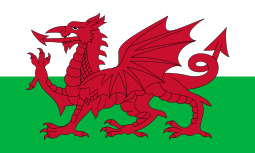
(The modern Welsh flag)
Y Ddraig Goch first appears in the tales of the Mabinogi (Charlotte Guest version) in the tale of Lludd and Llefelys where it is fighting a white dragon. The fight is also described/expanded upon in the c. 829 AD text Historia Brittonum (attributed to Nennius) - where the red dragon represents Wales and the white dragon represents the Anglo-Saxons. In the story the red dragon triumphs over the white. Of course, Geoffrey of Monmouth also covers the story c. 1136 in Historia Regnum Brittaniae in which he introduces the concept of the red dragon heralding the arrival of King Arthur.
Geoffrey of Monmouth claims Arthur used a banner featuring a golden dragon. But we also know the accuracy of Monmouth can be questionable at times. Owain Glyndŵr did use a banner with a golden dragon called Y Ddraig Aur - raised in 1401 at Caernarfon - Glyndŵr chose this banner as a nod to the supposed banner of Arthur and his father.
Later on the Tudor monarchs (being a Welsh family) adopted a red dragon on a white and green background in their heraldry. Eventually Y Ddraig Goch on a white and green background became the official badge of Wales in 1800. The design became the official flag of Wales in 1959.
Y Ddraig Traws:
Now for the thing you're all here for -
So, as outlined, the history of the dragon as a national symbol of Wales goes back a long way. If we're just talking post-1959, there's some interesting implications for Y Ddraig Goch's depiction.
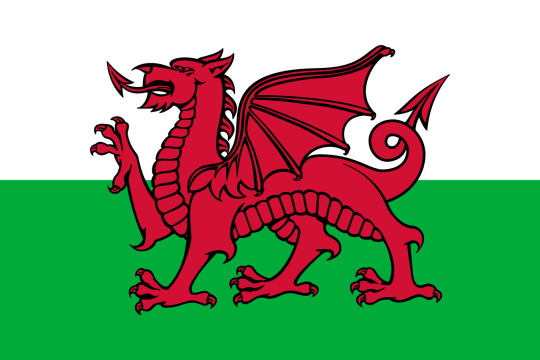
This is what the Welsh flag (and Y Ddraig Goch) looked like in 1959 when it was officially adopted as the flag of Wales. It looks broadly the same as the first flag and has some common features - such as not having a penis (or, as in the correct heraldic terminology - a pizzle). Meanwhile, in the arms of the Tudors (specifically Henry VII)
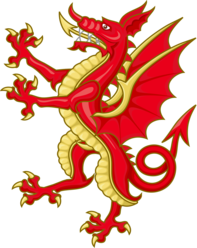
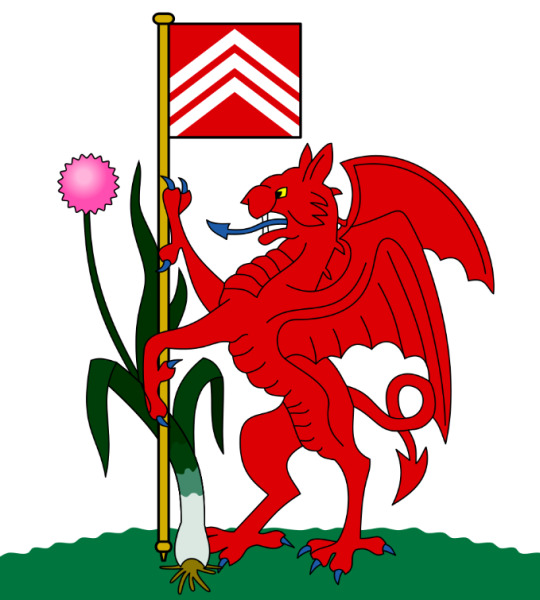
(Tudor dragon with pizzle) vs (dragon on the flag of Cardiff - pizzleless)
the penis is almost always included. So much to the point that the present royal family still includes the penis. While pretty much 0 depictions of the dragon in Wales include a penis. So you could interpret this as the dragon is seen as male only by the British royal family and as female everywhere else (which kinda implies that at some point the Tudor dragon had an mtf transition in Wales and she keeps getting misgendered by the royal family every time she is depicted in (mostly) England).
So much to the point that in 1995 this pound coin was made by the Royal Mint featuring the pizzle on the dragon with all four feet touching the ground as opposed to standing up (passant rather than rampant).

But in Wales you'd be hard pressed to see a pizzled dragon anywhere. Ergo, we can only conclude Y Ddraig Goch is trans and she transitioned in Wales and keeps getting misgendered in England.
[note: This is mostly tongue in cheek - but I do think it's fun to extrapolate that the Welsh dragon is trans because of the differences in depiction between Wales and England. Like many things Welsh, it is misrepresented by England and the idea of the Welsh dragon being misgendered only in England is, I think, a good metaphor for a whole lot of English treatment of Wales.]
Unrelatedly, there is a gay Welsh flag held at the National Museum of Wales which has a very wonky dragon which I find very endearing.

(cleaned up version I made)
So much so I made it an emoji in my Welsh bilingual LGBTQIA+ Discord (requirements for joining are - be 16+, either speak or are learning Welsh and identify as LGBTQIA+ in some way. Dm for link!).

(triaist ti 'you tried' emoji)
~ Completely unrelatedly ~ never forget the time someone was trying to homophobic to me by suggesting that I was disrespecting all the soldiers who died 'for the Welsh flag' by making it rainbow colours and not red - arguing that any change of colour of the dragon was disrespectful. Reader, my bus pass at the time for Mid Wales Travel had a purple dragon on it.
#cymraeg#welsh#cymblr#cwiar#trawsryweddol#traws#trans#trans dragon#y ddraig goch#welsh dragon#welsh history#dragons#wyverns#last tag because technically Owain's golden dragon is technically a wyvern
490 notes
·
View notes
Text

The Wide World of Wales episode of the FX series Welcome to Wrexham, for which the Crash Course team created a short History of Wales segment, recently won a Creative Arts Emmy for Outstanding Directing for a Reality Program!

Crash Course History of Wales is part of a fun and informative tour through different aspects of Welsh culture. Congratulations to the whole team who worked on this unique episode of TV!
#emmys 2024#creative art emmy#crash course#history#crashcourse#education#Wales#Welsh history#history of wales
146 notes
·
View notes
Note
Do you have anything on welsh queer history? You have scotland, ireland and england on the list but not wales as far as I can see :(
Hello! It looks like you found one of the gaps in our tagging system because I am delighted to share we have written about Welsh people a couple of times now, I will be going to fix this issue soon, until then, here are the links!
#queer history#queer#lgbt#lgbt history#gay history#answered#lesbian history#making queer history#welsh history#queer wales#lgbt wales
484 notes
·
View notes
Text
Americans can come up with the most idiotic and outright disrespectful things imaginable so effortlessly. I saw a post about an American "witch" claiming that she saw a "Celtic fae" in her back garden (in TEXAS) "picking flowers and eating berries" and the next day her husband told her she was "speaking gaelic in her sleep" (her words) first things first the Irish language is called Gaeilge NOT gaelic, gaelic is an adjective essentially we use it in things like gaelic football etc, secondly I can guarantee she did not see a fae in Texas??? Like that should be common sense??
Thirdly faes and fairies are VERY different things, if you're going to pretend to be knowledgeable on Celtic legends and lore at least know the bare minimum, faes are not friends, they are not a force to be reckoned with, if you somehow meet and annoy a fae it can and most probably will harm you and everything you love both physically and mentally.
And I know I can't be nitpicky but if you are going to use Irish words in your vocabulary please for the love of life at least try and pronounce it right, wtf is belt-tane (bhealtain) and Fawm-hair (fomhair)
Our language and culture is not you magical, fairy, witch aesthetic or lifestyle, it is genuinely disrespectful. We have such a rich, beautiful history and it's so easy to learn and talk about it in a respectful way, infact I think everyone should learn actually Irish/Scottish/Welsh history because it helped shape many things in our world e.g religion and fairytales.
If anyone who sees this wants to know more about Ireland or Celtic history/folklore or lore please ask me I'd love to share
#irish#irish history#irish literature#irish art#irish folklore#irish music#scottish#welsh history#celtic folklore#gaeilge#legends#faes#an bhean si#the salmon of knowledge#rant over
174 notes
·
View notes
Text
Can we talk about Owain Glyndŵr real quick?
This man pulled most of Wales into a 15 year-long revolt against the English using guerilla tactics and even managed to get a good word in with Scotland and France, right?
And then he dissappeared in 1415. No murder, no capture, he just vanished into the ether before his son took the free pardon from England that he adamently refused.
15 years. And he just poofs. He died of natural causes on-record but I don't know if that's been confirmed.
That's probably the part that makes him a great legend, thinking about it... a prince who revolted against the English crown for so long, only to vanish instead of meeting a brutal end is good story material. And it is, according to popular Welsh mythos! The man went down in legend as one of those heroes who would one day return.
Don't expect the Welsh-posting to slow down any time soon by the way. You have been warned.
121 notes
·
View notes
Text
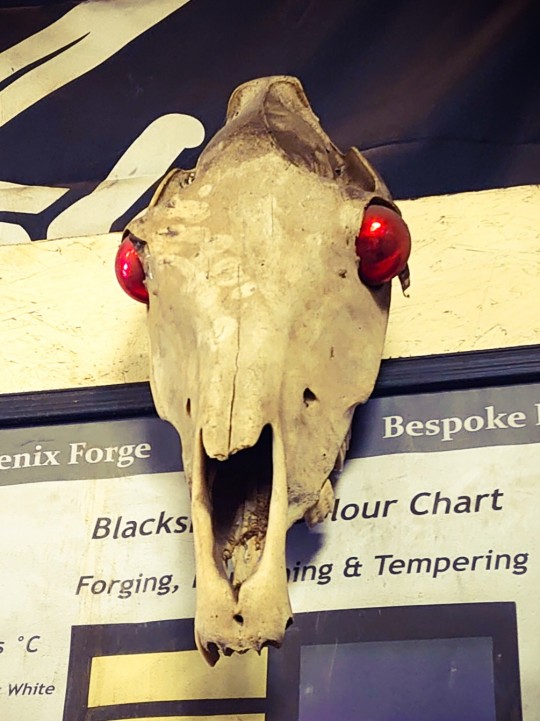
Mari Lwyd, keeping an eye on the forge.
56 notes
·
View notes
Text
“welsh remus” okay fine yes but have you also considered remus with romani ancestors
#not projecting#wolfstar#incorrectwolfstar#remus lupin#romani history#roma people#romani people#welsh folklore#irish folklore#welsh history#sirius black#sirius x remus#romani heritage
41 notes
·
View notes
Text

Books and castles; two of my favourite things 🏰📚
@literaryleisha on Instagram
#Bookstagram#book blogger#books#reading#Jane Austen#classic lit#dark academia#light academia#bookish#Booklr#Castles#Castle#Wales#Welsh#welsh history
539 notes
·
View notes
Text
This video has taught me just how complicated sourcing can be and how easily claims can become misinformation taken as fact. My ability to research and source feels so incredibly inferior. Its a good watch.
#sourcing#resources#research#youtube#I feel i should strive to be MUCH better#welsh history#wales#welsh#henry vii#house of tudor#british#medieval history#Cadwaladr#red dragon#flag of wales
48 notes
·
View notes
Photo

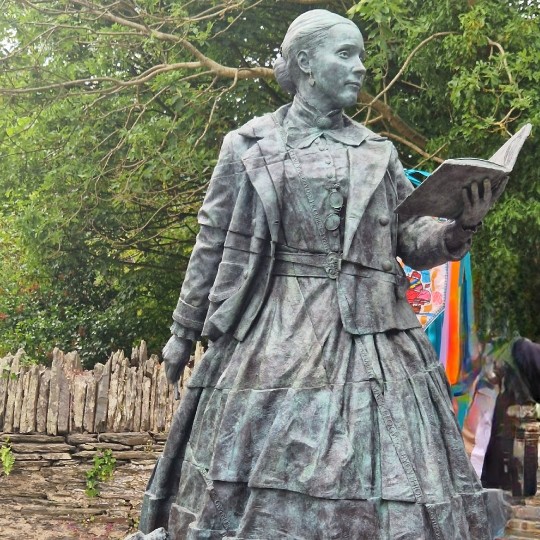
Cafodd cerflun o Cranogwen ei dadorchuddio penwythnos yma yn Llangrannog!
This statue of Cranogwen was unveiled in Llangrannog over the weekend!
Read about the Queer Life of Cranogwen here.
(Image source 1) (Image source 2)
#cranogwen#wales#welsh#cymru#cymraeg#sarah jane rees#queer history#welsh history#history#m#I posted more thoughts on Twitter and may post more#I started this blog because of Cranogwen and how her queerness was being left out of her history then!#a lot has changed since then especially as this was unveiled during Pride Month
79 notes
·
View notes
Text
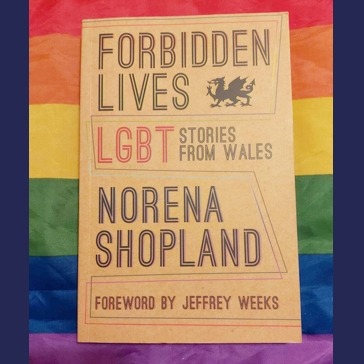
Y llyfr heddiw yw 'Forbidden Lives' gan Norena Shopland, a gyhoeddwyd yn 2017.
Mae'r llyfr hwn yn gasgliad o hanes LHDTC+ Cymru. Mae'n un o'r ychydig lyfrau ar y testun Cymru a pobl LHDTC+ (fel Llyfr y Dydd ddoe ac echdoe!). Mae'r ysgrifen Shopland yn goeth a manwl iawn. Mae hi'n defnyddio ei hymchwil yn y llyfr i ddangos hanes bobl LHDTC+ aneglur, fel Edith Gertude Phillips (g. 1886). Mae Shopland yn disgrifio hanes pobl LHDTC+ nodedig fel y Eleanor Butler a Sarah Ponsonby, hefyd.
Mae'r llyfr hwn yn un o fy hoff lyfrau!
Ydych chi wedi darllen y llyfr hwn?
/
Today's book is 'Forbidden Lives' by Norena Shopland, published in 2017.
This book is a compilation of Welsh LGBTQ+ history. It is one of the few books on the subject of Wales and LGBTQ+ people (like the Book of the Day yesterday and the day before yesterday!). Shopland's writing is exquisite and very detailed. She uses her research to show the history of less well-known LGBTQ+ people, such as Edith Gertude Phillips (b. 1886). Shopland describes the history of more well-known LGBTQ+ people also.
This book is one of my favourite books!
Have you read this book?
33 notes
·
View notes
Text
Elphael: What's In a Name?
Earlier today, my esteemed comrade @the-unkindled-queen made a post wondering about the etymology of Elphael, Brace of the Haligtree. My initial digging turned up a few Reddit comments where the general consensus was that Elphael has its roots (ha) in Hebrew linguistics, with one interpretation being "Family of God" and another being "Work of God":


Now as a linguist and Bible scholar, I think these are awesome. I love seeing all the languages and cultures that these games draw inspiration from, and the Hebrew connection is a neat contrast with the Haligtree itself, which is linguistically Welsh. Additionally, the connection to Abrahamic faith and Hebrew words for people and acts of God is a nice throughline for the way the game portrays Miquella and St Trina as Messianic protectors of the sick and poor. Add in the spiritual atmosphere of Elphael and the Haligtree (prayer rooms, mausoleums, and altar-like statues of Miquella and Malenia abound), and it's a very pleasing little theory.
Soulsborne and especially Elden Ring borrow heavily from Welsh for names and whatnot (like the aforementioned Haligtree), and out of idle curiosity I began to wonder if there was any basis whatsoever for an alternative theory linking Elphael's name to Welsh. My only reasons for going down this path were the vaguely Celtic sound of the name and the fact that the Haligtree proper has a Welsh name. I didn't find anything like this during the search that led me to the Hebrew theories, and plugging various fragmentations of "Elphael" into a Welsh->English translator didn't spit out anything of value. I was about to throw in the towel when I did what I probably should have done before faffing about with the translator and just searched "Elphael Welsh."
And oh golly do we have ourselves an Elphael. Or an Elfael.
Welcome to the infinitely confusing world of medieval Welsh history.
Medieval Wales was divided into several regions, called cantrefi. Each cantref was further divided into several territories called commotes. The cantrefi are pictured below. We're mostly concerned with the central yellow one, Rhwng Gwy a Hafren, but also remember Gwynedd. It's in orange up top.
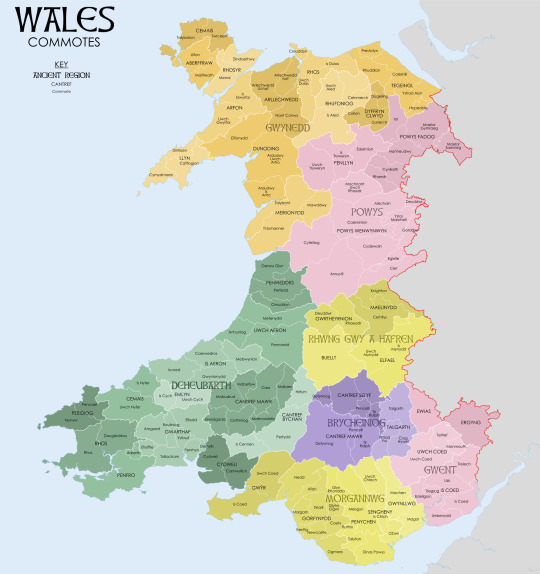
But that's for later. What we care about right now is the cantref of Rhwng Gwy a Hafren, which lies between the rivers Wye and Severn. This cantref is shown in detail below and is home to the commote of Elfael, shown in green. Also take note of Maelienydd and Buellt. They're light blue and yellow respectively, and we're going to need them later.

The history of Elfael is short and confusing, as one can expect from a fiefdom straddling the English-Welsh border during the post-Roman and post-Norman Conquest years. It didn't exist as a political entity for very long (it was only independent from 1155ish to about 1215 before dissolving completely in 1309), and changed hands often during its lifetime.
Our story begins with a man named Elystan Glodrydd, Prince of Buellt. He lived from 950 to 1010 CE, and at some point during his later life he conquered a territory called Ferlix, which was composed of Elfael and Maelienydd. When Elystan died, rulership of Buellt (Ferlix included) passed to his son Cadwgan, and then to Cadwgan's son Idnerth when he died.
Idnerth's reign is remarkable because he's the guy who lost Buellt. An Anglo-Norman noble, Philip De Braose, had conquered basically all the land between the Wye and Severn, which of course included Buellt. For some reason, at the conclusion of his conquest De Braose gave Ferlix back to Idnerth, but kept Buellt for himself. The end result being that Idnerth had gotten kicked out of his grandpa's commote and into what had originally been a conquered vassal territory. Once Idnerth died (presumably in shame), Ferlix went to his son, a man with the astoundingly awesome name of Madog. During this time, the Anarchy was starting.
The Anarchy was a civil war in Britain from 1138 to 1153. King Henry I died in 1135, and his heiress, the Empress Matilda, had many enemies who didn't want her to take the throne. In 1130, a castle had been built in southern Ferlix by one of these enemies, an Anglo-Norman named Pain FitzJohn, Sheriff of Hereford. This is the actual best name in this story. Pain FitzJohn is a fucking badass name. This castle, which was of course called Pain's Castle, was acquired by Madog in 1135 under foggy pretenses. It's likely that Pain wanted Madog's protection from Matilda, but we're not sure.
Old Madog knew that getting a castle called Pain's Castle was an achievement that couldn't be topped, and proceeded to die at age 65 in 1140, secure in the knowledge that he was better than Idnerth. He left five sons, who bucked the trend of going to war for their dead dad's land by dividing Ferlix amongst themselves. Unfortunately for them, this is when the Anarchy caught up with them. Another Norman lord, Hugh De Mortimer, invaded Ferlix in 1142. Two of Madog's sons (Hywel and another Cadwgan) were killed, and in 1146 De Mortimer killed a third son, Maredudd, in the process of capturing Pain's Castle. In 1155, Matilda's son Henry II took the throne of England, and when Hugh De Mortimer protested, Henry kicked him out of Ferlix. This left Madog's two surviving sons, Einion Clud and Cadwallon, to pick up the pieces. These guys hated each other, and neither brother could stomach ruling in consort with the other. But for some reason, they didn't kill each other, instead dividing Ferlix again in two. Cadwallon got the northern part, which came to be called Maelienydd, and Einion Clud got the southern part, which was called Elfael.
Einion Clud and Cadwallon still hated each other, and their realms were openly hostile, each brother still believing he was entitled to sole rule of all that had once been Ferlix. (Again, why didn't they just fight to the death like every other medieval family?) Things came to a head in 1160, when Cadwallon kidnapped Einion Clud and sent him in chains to Owain Gwynedd, the aptly-named King of Gwynedd, who in turn pawned him off on King Henry II. Eventually, Einion Clud either escaped or was released. It's not certain which of these occurred, but what is certain is that by 1165, Einion Clud was once again ruling Elfael, and at the Battle of Corwen the two brothers fought together against King Henry under the leadership of Owain Gwynedd. Politics are fucking weird.
There would be no happy ending, however. Hugh De Mortimer's son Roger was swearing revenge on his father's enemies. You might take this to mean King Henry, who kicked Hugh De Mortimer out of Ferlix in 1155, but no, Roger was actually a big fan of Henry II and had fought for the King during the Revolt of 1173. No, Roger wanted revenge on the guys who ruled Ferlix after his dad got yanked. The timeline here is a bit weird, but what's certain is that Roger De Mortimer killed Cadwallon in 1179. He also killed Einion Clud, but I wasn't able to find out when. I found a source saying that Roger killed Einion Clud after his father died, but Hugh De Mortimer died in 1181 and my reading on Cadwallon says that he was the prince of both Maelienydd and Elfael at the time of his death, which would only be possible if Einion Clud died before 1179. In fact, Cadwallon is said to have been ambushed by Roger's men in Elfael.
Anyway, that's all the history we care about for our purposes. Maybe I'm reading too much into things, but the fact that medieval Wales has the Lord of Elfael getting kidnapped by his brother seems a bit on the nose.
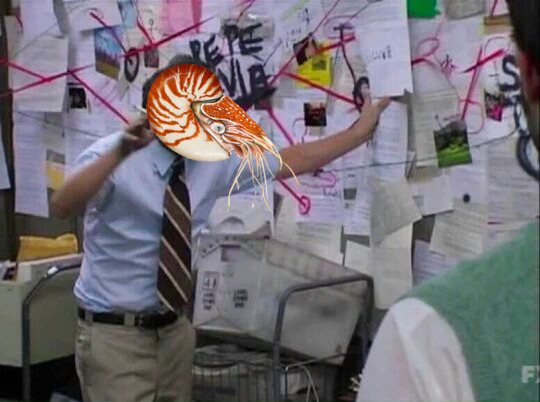
In Welsh history, the Anarchy leaves three of Madog's sons dead and the survivors are on opposing feudal factions. The Lord of Elfael is kidnapped by his brother.
In Elden Ring, the death of Marika's son sparks the Shattering, turning every remaining demigod against each other. The Lord of Elphael is kidnapped by his brother.
Either Miyazaki and Germ are fucking Super Saiyan level Welsh history scholars, or this is just an absurd coincidence. Either way, it's cool.
(tiny sidenote: this part is DEFINITELY conspiracy, but isn't it funny that our kidnapped lord has a sibling who rules Maelienydd??? Doesn't that sound a bit like... Malenia??? Obviously Malenia doesn't do the kidnapping in ER, but the names line up a bit too well...)
Sorry Niko, this is way more than you bargained for.
#elden ring#wales#welsh history#medieval history#elden ring lore#miquella the unalloyed#mohg the omen#malenia blade of miquella#the shattering#queen marika the eternal
61 notes
·
View notes
Text
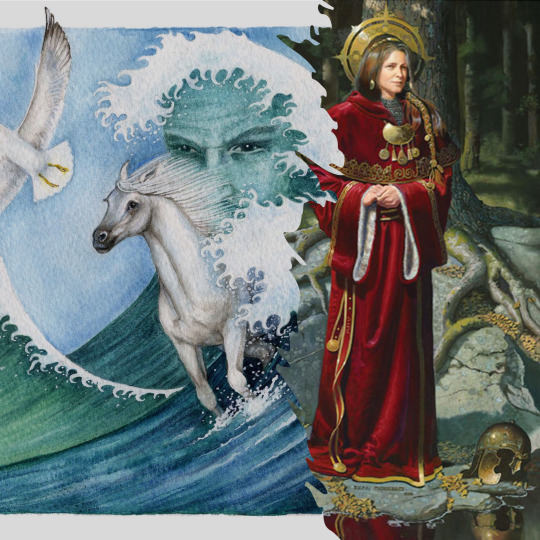
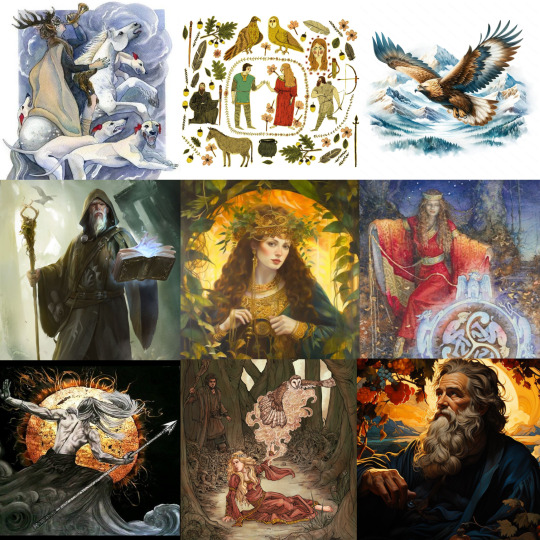

The Houses of the Mabinogi
The Houses of Dôn and Llyr are connected by marriage through Llyr's wife, Penarddun but are diverse in their stories and personalities.
Dôn collage to the bottom left, Llyr collage to the bottom right.
The House of Dôn, apart from the mother goddess herself, boasts two powerful magicians: Math and Gwydion. Also the Goddess of the Wheel of the Year, Arianhod, and her estranged son Lleu Llaw Gyffes are popular characters of this house. The children of Dôn also include Amaethon, the god of agriculture and who started the 'Cad Goddeu' or Battle of the Trees, where all the children declared war against Arawn, King of Annwn. They only won due to Gwydion's expert wizardy with his summoning of a tree army. Finally, the grandson of Dôn, Gwyn, son of Nudd, is popular in Welsh folklore as the king of the Tylwyth Teg (fairy-folk) and leader of the Wild Hunt.
The House of Llyr is smaller in sized but full of tragedy.
Llyr has two sons and one daughter, Branwen. She gets betrothed to the King of Ireland, Matholwch. On return to ireland though, she gets forced into the kitchens. After hearing of his sisters plight, Bran the Blessed, a giant and the King of Britain, wades across the Irish Sea with an army of Welshmen, including his brother and trusted advisor Manawydan. After the tragic death of Branwen's son Gwern, the Welsh and Irish fight until no-one is left but Bran, Branwen, Manawydan and six Welshmen. Unfortunately, Bran finds a poison arrow in his leg and as he is dying, asks Manawydan to cut off his head and take it back to Wales. Upon their return, Branwen dies of a broken heart from her brother and sons death.
#cadno#celtic paganism#wales#welsh pagan#welsh witch#witchcraft#celtic magic#celtic witch#mabinogi#mythology and folklore#celtic mythology#welsh history#history#paganism#pagan#deity work#deity worship#witchblr#witches#witch community
12 notes
·
View notes
Text
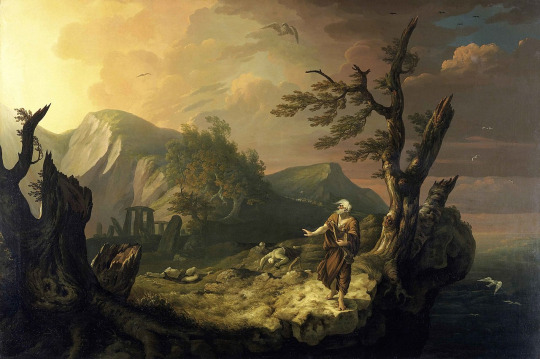
Thomas Jones (1742-1803)
"The Bard" (1774)
Oil on canvas
Romanticism
Located in the National Museum, Cardiff, Wales
Poised on the edge of cliff clutching a harp, the last surviving bard places a curse on the English invaders before leaping to his death. This dramatic history painting has become iconic for Wales. Based on Thomas Gray’s poem "The Bard," it recounts the tale of Edward I’s massacre of the Welsh bards.
Bards were highly regarded in Welsh society at that time, and were thought to be descendants of the Celtic druids. Jones makes this connection by giving his Bard druidic features – a long white beard and hooded robe. The stone circle in the background, based on Stonehenge, emphasizes the antiquity of the druid.
#paintings#art#artwork#history painting#welsh culture#thomas jones#oil on canvas#fine art#romanticism#romantic movement#welsh artist#history#welsh history#landscape#national museum of wales#museum#art gallery#death#violence#1770s#late 1700s#late 1800s
101 notes
·
View notes
Text
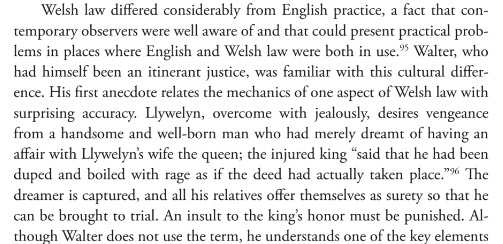


(From Walter Map and the Matter of Britain by Joshu Byron Smith)
8 notes
·
View notes
Text
Woad:Stone to Stone is a solo journaling TTRPG based on Welsh Mythology and inspired by history. Travel through mythic Cymru in the 12th Century with a celtic Tarot Deck as your guide!
Fight the English. Befriend the Fae. Seek the Fae.
Woad was funded in 48 hours, as it nears the completion of it's kickstarter campaign help us unlock more stretch goals by backing now!

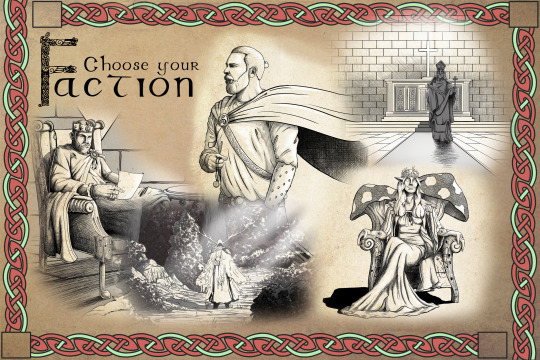

#ttrpg#kickstarter#tarot cards#tarotcommunity#ttrpgfamily#wales#welsh mythology#mythology#fae folk#welsh history#solo games#journaling#tabletop#mabinogi#cymru#celtic knotwork#celtic mythology#celtic knots#tarot
58 notes
·
View notes